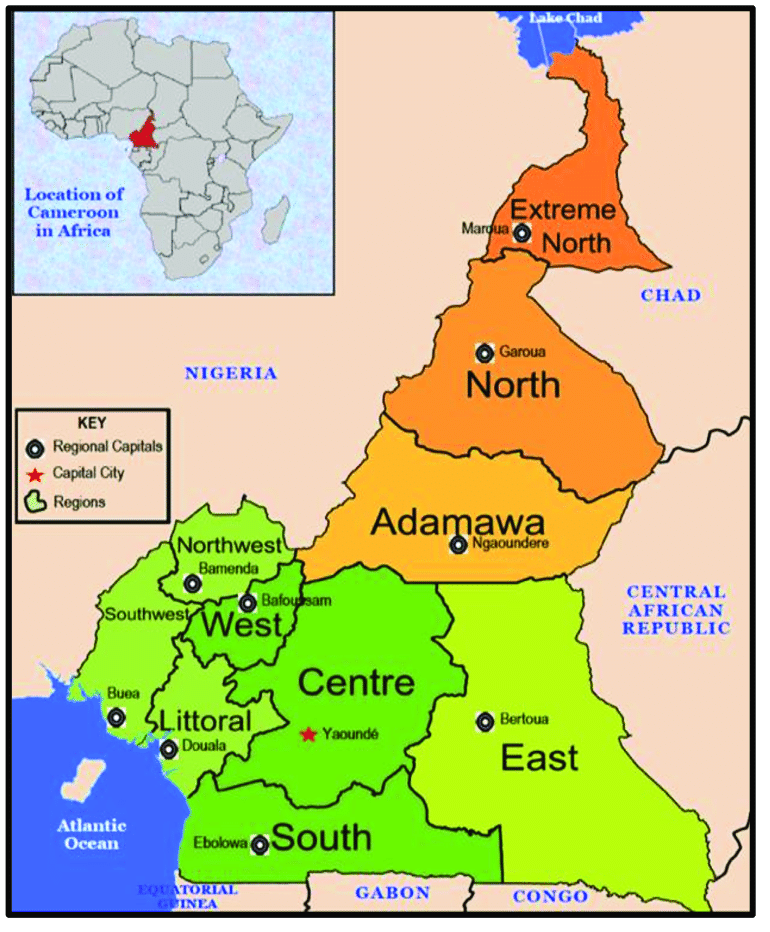Cameroon the “Africa in miniature”

Cameroon is strategically positioned between West and Central Africa. With the rough size of Spain and nearly 25 million people it makes it relatively sparsely populated. But on the other hand the fact that around half of its population lives in the metropolitan areas puts it in a prime position to develop industry and commerce.
Cameroon is subdivided into ten major regions. Douala the economic capital and the biggest port in the country, Yaounde the political and administrative capital.
Based on the colonial history of Cameroon. It was “discovered” by Portuguese explorers in the 15th century and named Rio dos Camarões (Shrimp River). At the end of the 19th century it became a German colony (Kamerun). After WWI the country was divided between France and the United Kingdom.
Cameroon, as we know it, was established when in 1960 the French part became independent. It was joined by the Anglophone region in 1961 forming a Federal republic – with both parts keeping a semblance of independence. In 1972 the federation was abandoned. The proverbial disdain between the Englikanized and Frankofonized population continues to this day and has recently escalated to a civil war recognized by the US.
The governmental power stems from the president (H.E.Paul Biya aged 89 since his first election in 1982). He appoints government officials at all levels, from the prime minister (considered the official head of government), to the provincial governors and divisional officers.
The Legislative branch is divided into the National Assembly and the Senate, however both at present hold only nominal power.
The constitution divides Cameroon into 10 semi-autonomous regions, each under the administration of an elected Regional Council. Each region is headed by a presidential appointed governor.
The government recognizes the authority of traditional chiefs, Fons, sultan and Lamibe to govern at the local level and to resolve disputes as long as such rulings do not conflict with national law.
The president appoints judges at all levels. Cameroon’s legal system is a mixture of civil law, common law and customary law.
Unsurprisingly Cameroon is rife with corruption – Transparency International ranked Cameroon 152 on a list of 180 countries in 2018. Although press freedoms have improved since the first decade of the 21st century, the press is corrupt and beholden to special interests and political groups.
This is however expected to change, as the population is getting more and more educated. Cameroon has one of the highest school attendance rates in Africa. In 2013, the primary school enrollment rate was 93.5%. Secondly, cell phone networks and Internet providers have increased dramatically since the first decade of the 21st century and are largely unregulated. This indicates large potential for businesses focused on modern marketing and communication.
Cameroon has had a decade of strong economic performance, with GDP growing at an average of 4% per year. Uniquely among the growing African countries this is not facilitated by large scale exploitation of natural resources. Cameroon possesses substantial mineral resources, but these are not extensively mined. Petroleum exploitation has fallen since 1986, but this is still a substantial sector such that dips in prices have a strong effect on the economy – which would presume that the near future will see large possibilities for investment by local companies.
It is still largely an agricultural nation. An estimated 70% of the population farms, and agriculture comprised an estimated 16.7% of GDP in 2017. Large numbers of Cameroonians live as subsistence farmers. Soils and climate on the coast encourage extensive commercial cultivation of bananas, cocoa, oil palms, rubber, and tea. Inland on the South Cameroon Plateau, cash crops include coffee, sugar, and tobacco. Coffee is a major cash crop in the western highlands, and in the north, natural conditions favor crops such as cotton, groundnuts, and rice. Production of Fair-trade cotton was initiated in Cameroon in 2004. The southern rain-forest has vast timber reserves, estimated to cover 37% of Cameroon’s total land area. However, large areas of the forest are difficult to reach.
Factory-based industry accounted for an estimated 26.5% of GDP in 2017. The government has taken measures to encourage tourism in the country which also indicates possibilities for investment. But care should be taken when doing so, as a “hands and eyes on” approach is required.
Cameroon’s relatively large and diverse population is also diverse in its contemporary fashion. Traditional arts and crafts are practiced throughout the country for commercial, decorative, and religious purposes. Wood carvings and sculptures are especially common. The high-quality clay of the western highlands is used for pottery and ceramics. Other crafts include basket weaving, bead-working, brass and bronze working, calabash carving and painting, embroidery, and leather working. All these sectors are ripe for investment and export, but must be curated so as to meet the demands of the fickle western market hungry for exotic and diverse items.
Cameroon the “Africa in miniature” Read More »
